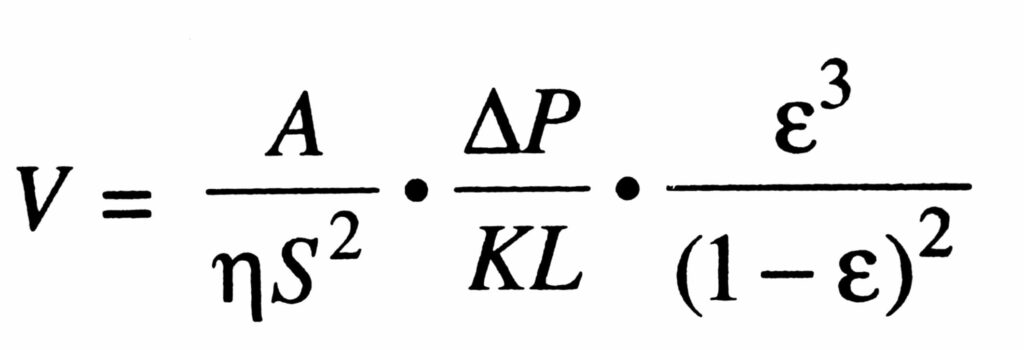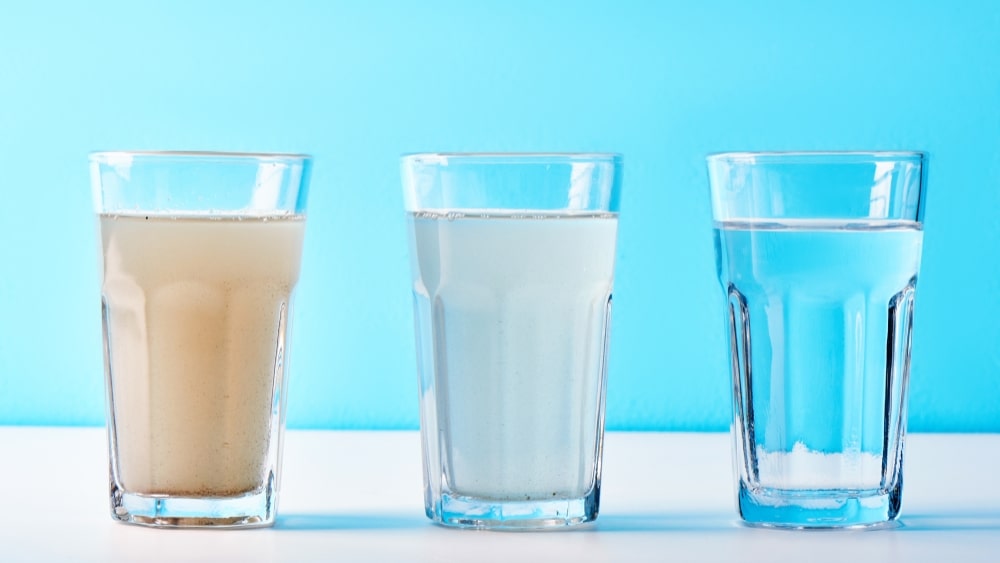A simple straining process does not provide a complete description of how particles are removed from a suspension. The particles are exposed to a number of forces including gravity or electrical fields Some of the factors influencing the filtration are:
- Properties of the liquids-density, viscosity, and corrosiveness.
- Properties of the solids-particle shape, particle size, particle charge, density, particle size distribution, rigidity or compressibility of the solid under pressure, and the tendency of a particle to flocculate or adhere together.
- The proportion of solids in the slurry rate at which the filter cake is formed, especially in the early stages of the filtration.
- Objectives-whether the solids or the liquid or both are to be collected.
- The temperature of the suspension.
Table of Contents
Kozeny-Carman Equation
Poiseuille’s equation is made applicable to porous beds, based on a capillary type structure by including additional parameters. Thus the resultant equation, which is widely used for filtration is the Kozeny-Carman equation.

Where,
e = porosity of the cake (bed)
S = specific surface area of the particles comprising the cake, m²/m3
K= Kozeny constant
Limitation of Kozeny Carman equation: Kozeny Carman equation does not take into account the fact that the depth of the granular bed is lesser than the actual path traversed by the fluid. The actual path is not straight throughout the bed, but it is sinuous or tortuous.
Surface Area of the Filter Medium
According to equation (1), the rate of flow of filtrate flowing through the filter is inversely proportional to the specific surface of the filter bed. On the other hand, if the surface area of the filter medium is considered, the rate of filtration is directly proportional to the surface area of the filter medium. Hence, the rate can be increased either using a larger filter or connecting a number of small units in parallel. For example, the filter press works on the principle of connecting the units in parallel. Pleating the filter paper or using a pleated funnel increases the effective surface area for filtration.
Pressure Drop Across the Filter Medium
According to equation (1), the rate of filtration is directly proportional to the overall pressure drop across the filter medium and filter cake. The pressure drop can be achieved in a number of ways:
Gravity: A simple method of obtaining a pressure difference is maintaining ahead of slurry above the filter medium. The pressure developed depends on the density of the slurry. As a rough guide, ahead 10 meters of water creates a pressure difference of 100 kilopascals.
Applying pressure: The most common method of obtaining a pressure difference is applying pressure on the surface of the slurry, i.e., pumping the slurry onto the filter.
The pressure difference obtained by this method is greater than that. is achieved by reduced pressure. The industrial plant may be operated at pressure up to 1500 kilopascals. However, in the early stages of filtration, the pressure difference should be less. This is to prevent the pores of the filter medium from clogging or plugging, which subsequently, resistance to the flow.
Reducing pressure: The pressure underneath the filter medium may be reduced below atmospheric pressure by connecting the filtrate receiver to a vacuum pump. This creates a pressure differential across the filter. This factor has limited applications because the pressure difference of about 100 kilopascals may be achieved. Reduction of pressure lowers the boiling point of liquids so that it is possible for the filtrate to boil in the receiver. Apart from the loss of liquid, the vapor may damage the vacuum pump.
The advantage of this method is that it is safe. If a part of the equipment fails, it will collapse and not explode. Therefore, this method is commonly applied in a laboratory, where the apparatus is usually made of glass. However, on an industrial scale, the plant is usually constructed with a metal that is able to withstand high pressure.
Centrifugal force: Centrifugal force could replace the gravitational force and is used to increase the rate of filtration.
Viscosity of Filtrate
According to equation (1), the rate of filtration is inversely proportional to the viscosity of the fluid. The viscosity of the liquid, not the slurry is important since the resistance to flow occurs as the filtrate flows through the filter cake…
Raising the temperature of the liquid lowers the viscosity. may increase the rate of filtration. This is not practicable, if thermolabile materials are involved or if filtrate is volatile. Another alternative to decrease the viscosity is to dilute the filtrate. In this case, it is to ensure that by doubling the volumes, the rate must be more than double, which should indicate the advantage.
In brief, surface area and pressure differences are the two factors, which are applied, in industrial practice. According to equation (1). other factors such as porosity also influence the rate of filtration. These are discussed below with filter aids.
Make sure you also check our other amazing Article on : Mechanism of Filtration
